There’s no doubt about it, discovering bed bugs in your home is horrifying. When you see tell-tale signs of bed bugs, you need to take action right away because they multiply quickly and can spread to every corner of your home To get rid of bed bugs in your home, you’ll need a multi-faceted approach.
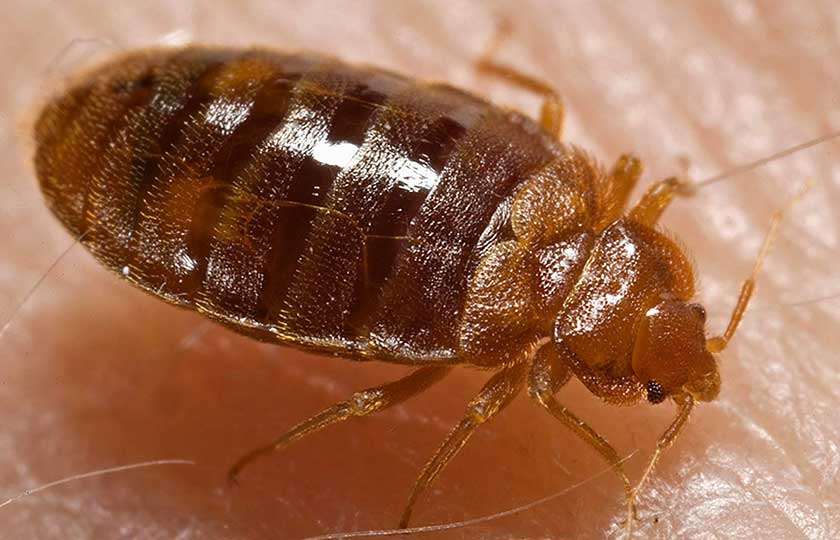
Unfortunately, there’s no single product or method that’s completely effective. People that tell you otherwise are just trying to get you to buy their product. Bed bug sprays can be part of your plan to kill bed bugs, but only a couple of products actually work. In this guide, I’ll share with you the two best bed bug sprays, which ones to avoid (most), and the steps you need to take to banish bed bugs from your home.
Here Are the Best Bed Bug Sprays
1. Bed Bug Patrol
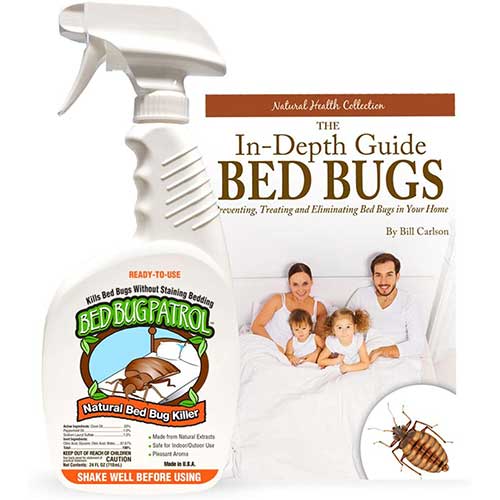
Bed Bug Patrol is an eco-friendly and all-natural solution to a bed bug problem. It’s made from different plant extracts, however, with active ingredients that include peppermint oil (1%), clove oil (0.003%), and sodium lauryl sulfate (1.3%).
Bed Bug Patrol isn’t quite as effective as EcoRaider, especially when it comes to killing bed bug eggs. There are some areas in which Bed Bug Patrol shines. It won’t leave visible residue or stains. You may also find the aroma more pleasant. It also comes in a variety of sizes including 1 gallon and a 3-ounce TSA-approved travel size.
Key Features include Scientifically proven ingredients, leaves no residue or stains, and has a pleasant smell.
2. Eco-Defense Bed Bug Killer Spray
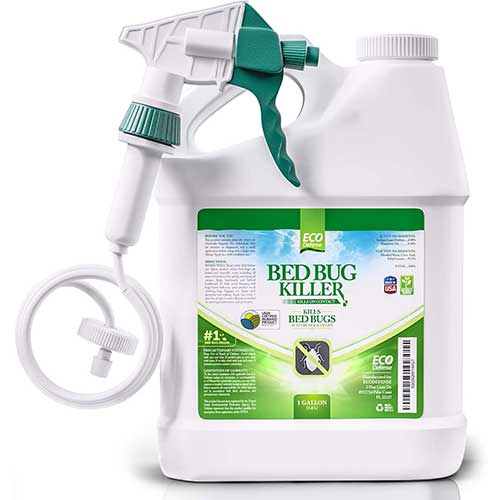
Eco-Defence Bed bug spray spay is a treatment to use in infested areas. This spray is organic and has non-toxic ingredients. It can be applied to sheet and bedding and kills bugs on contact. The spray kills bed bugs in all stages including eggs, nymphs, and full grown bed bugs. This is a popular treatemtn to use against bed bugs.
Eco Defence does not use pesticides or poisonous ingredients which makes it safe to use around pets and kids. The active ingredients are sodium lauryl sulfate and germanium oil.
3. EcoRaider Bed Bug Killer Spray
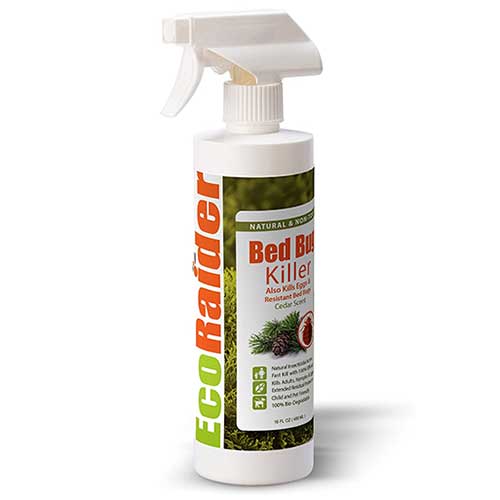
EcoRaider is a low-cost, non-toxic, and eco-friendly bed bug spray that’s made from botanical, natural ingredients. The active ingredients include cedar extract (1%), geraniol (1%), and sodium lauryl sulfate (2%). When you spray it, you’ll notice the eucalyptus and cedar odor which is a nice bonus compared to most pesticide products.
Bed bugs have proven they’re great at adapting and evolving resistance to traditional pesticides but EcoRaider is still quite effective, killing all bed bugs on impact within 10 days. It’s a good choice to help treat materials that can’t be run through your dryer like seams and nooks in furniture, area rugs, and luggage.
It’s available as a small bottle that can help you treat luggage on the go or smaller areas. For treating your home, go with the large 32-ounce EcoRaider Bed Bug Killer linked above. Studies using this spray have shown 100% bed bug mortality. There are multiple sizes available.
How effective is EcoRaider?
In the Rutgers University study, EcoRaider caused 100% mortality in bed bugs after 10 days in two separate trials. When sprayed on bed bug eggs, the hardest life stage to kill, EcoRaider still caused high mortality of 86%.
EcoRaider was by far the most effective solution tested against bed bug eggs. It’s also comparable to professional pesticide results.
It didn’t cause mortality over 75% at three days, however; it takes a while for EcoRaider to take effect. This is one area where Temprid SC, a professional-grade pesticide, comes out ahead.
Do Bed Bug Sprays Work?
Most bed bug sprays on the market use plant oils or detergent-based insecticides. The truth is the vast majority of these products aren’t good for anything aside from making your house smell fresher.
According to a major study from Rutgers University, there are two low toxicity bed bug sprays that do work against bed bugs, nymphs, and sprays: EcoRaider and Bed Bug Patrol.
Both use plant oils to kill bed bugs.
This is surprising because most essential oils are useless against bed bugs despite being touted as an “all natural bed bug repellents” and “bed bug killers.” You may see lavender oil and tea tree oil marketed for deterring bed bugs but the bugs don’t really mind them.
The only essential oil that alone has shown any promise against bed bugs is blood orange oil which can be combined with silicone and paraffin oils to suffocate the bugs. We’ll get to that later.
4. Ortho Home Defense Max
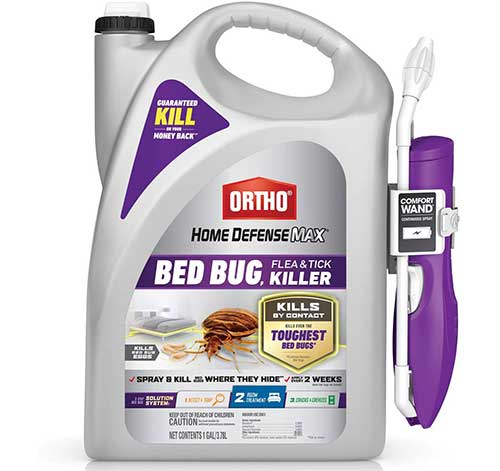
Ortho Home Defense Max is a bed bud spray that kills bed bugs on contact. As a general rule, most products you can buy on a shelf to treat bed bugs aren’t very effective. That’s because most contain pyrethrins, a botanical insecticide, or pyrethroids, which are a synthetic chemical insecticide that works in much the same way.
Bed bugs rapidly evolve resistance to chemicals. Across the world, bed bug populations are showing varying resistance to pyrethroids and pyrethrins.
With that said, a pyrethroid-based treatment can still be effective to some degree as long as it isn’t used alone and you don’t expect it to fix the problem.
You have no way of knowing how resistant the bed bugs in your home are to pyrethroids. in Cincinnati and New York, two cities hit hard by bed bug epidemics, bed bugs have shown moderate to significant resistance. Even in these regions, some bed bug populations have reduced resistance and may be more vulnerable to chemicals.
The bottom line is bed bugs aren’t universally resistant to pyrethroids. That’s where Ortho Home Defense Max may help.
Unlike many bed bug sprays out there, it doesn’t rely on pyrethroids alone. Active ingredients in Ortho’s bed bug spray include:
- 4% Sumithrin. This is a synthetic pyrethroid.
- 05% Imidacloprid. This is a neonicotinoid, an agricultural insecticide that resembles nicotine.
- 0% MGK 264. This is a synthetic chemical that works as a synergist. It doesn’t harm bed bugs but it’s used to make the pyrethroid more potent.
5. Harris Black Label Bed Bug Killer
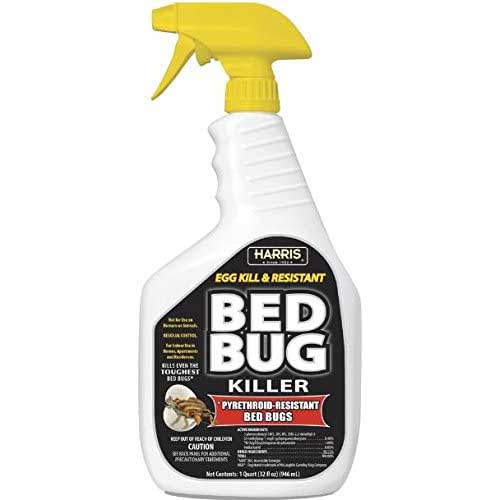
Harris is a strong bed bug spray that can be used against pyrethroid-resistant bed bugs. The spray is EPA registered for use in homes. It is an odorless non-staining spray that kills bugs for up to 16 weeks after applying the product. This spray can not be used on mattresses, pillows, bedding, or clothing. It is intended to be used on box springs, furniture, closets, carpet, and crevices around the house.
How To Detect Bed Bugs
Bed Bugs Detect and Lure Trap
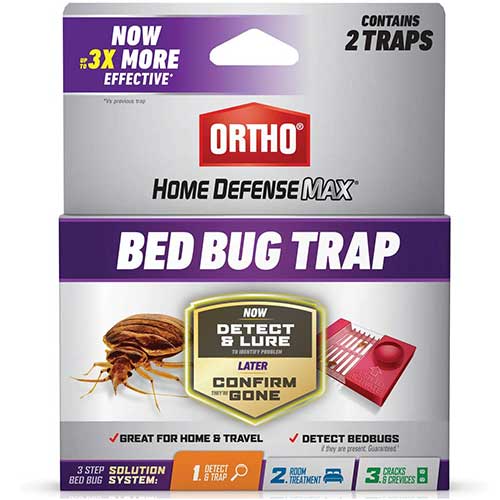
Bed bug traps are a great way to confirm bed bugs are in the area. Before deploying spray and powders make sure that there actually are bed bugs. This trap has a clear top so it can be checked daily to see if there are bed bugs around. Once bed bugs are found then a room treatment or cleaning process can be implemented.
Black Light to Detect and Spray Bed Bugs
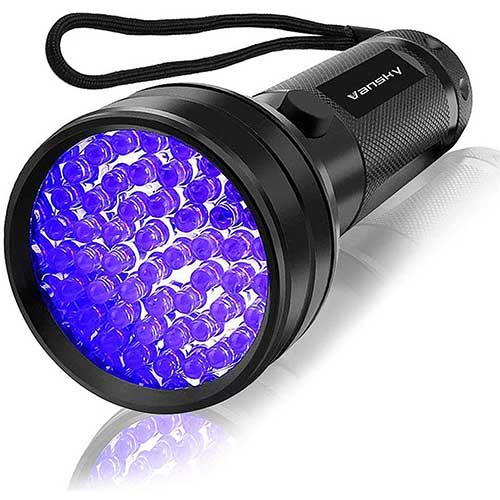
Bed bugs can be hard to find just by looking around as they hide in small crevices. A black-light can be useful to find bed bugs and other stains in bedding, carpet, and luggage. This light comes with batteries and UV sunglasses. The light does not kill the bed bugs and is only used to locate them. If bed bugs are found the area should be cleaned and traps, sprays, or powders should be used to get rid of them.
Related Article: 8 Best Bed Bug Killers
Bed Bugs Resistant to Sprays
Bed bugs have also developed resistance to neonicotinoids, according to a new study, but, as with pyrethroids, this isn’t universal. The study found that imidacloprid and other neonicotinoids killed bed bugs very quickly if they had no resistance. A pyrethroid-resistant population of bed bugs did not show any resistance to imidacloprid. The bed bugs from Cincinnati and Michigan, which were collected after widespread use of both neonicotinoids and pyrethroids, showed the highest level of resistance to neonicotinoids.
By combining both a pyrethroid and a neonicotinoid with a synergist, the Ortho Home Defense Max may just have success at killing bed bugs in your home even if they have some resistance to one or both chemicals.
The Rutgers Study on Biopesticides for Bed Bugs
The definitive Rutgers study compared biopesticides, synthetic insecticides, and detergents including Bed Bug Patrol, EcoRaider, Essentria, Green Rest Easy, Eradicator, Bed Bug 911, Bed Bug Bully, Rest Assured, Bed Bug Fix, Stop Bugging Me, EcoEXEMPT IC2, Demand CS, and Temprid SC. The last two are synthetic insecticides typically used in professional bed bug treatment.
The study involved two experiments. In the first, detergents and biopesticides were tested. Bed bug nymphs were placed on filter paper and treated directly with a pesticide spray then transferred to a clean plastic petri dish. Mortality was recorded at 1, 3, 5, 7, and 10 days after exposure.
The most effective biopesticides from this test were included with additional biopesticides and the two synthetic insecticides in a second experiment involving the same procedure.
The study clearly showed that EcoRaider and Bed Bug Patrol were the best natural pesticides producing high mortality rates after 10 days in both experiments. The other biopesticides caused 60% mortality or less after 10 days. Some even had no effect when directly applied to bed bugs.
Among the synthetic pesticides used in professional bed bug treatment, Temprid SC was found to be much more effective than Demand CS. Bed bugs have developed moderate tolerance to Demand CS.
While these results are very promising, it’s important to remember one thing:
These experiments involved applying the bed bug sprays directly to the bed bug’s body. That’s hardly representative of real-world conditions.
Let’s go into more detail about how Bed Bug Patrol and EcoRaider work where other sprays fail and why you shouldn’t rely on sprays alone to get rid of bed bugs in your house
Why You Shouldn’t Use Bed Bug Sprays Alone
EcoRaider and Bed Bug Patrol both deliver great results in a lab setting. They can both be great at controlling and reducing a bed bug population in your home but alone, they won’t be enough.
That’s because bed bugs in your house hide in crevices, creases, and tiny cracks. The effectiveness of these products will certainly be much lower when the bugs aren’t exposed directly to the product. When dry on a surface, they have a reduced effect.
When bed bugs were exposed to the day-old residue of Bed Bug Patrol and EcoRaider, 93% were dead after 10 days. This is encouraging but the residue was only 24 hours old. Because plant oils are volatile, they will probably break down within a matter of days or up to two weeks.
In a real-world environment, there’s no guarantee the bed bugs would even be exposed to the residue. It seems bed bugs will avoid surfaces treated with biopesticides but not necessarily surfaces with the residue of synthetic pesticides.
Ideally, you want products that:
- Kill directly on impact
- Leave a residue that continues to kill bed bugs
- Do not merely repel bed bugs which will go into hiding and live for months
To reach this goal, you should combine the best bed bug spray like EcoRaider with other proven solutions for conquering bed bugs.
Related Article:
How to Use Bed Bug Sprays to Kill Bed Bugs
To get the best effect with any bed bug killer, you need to use it correctly. With bed bug sprays, your goal should be spraying where you will likely make direct contact with bed bug nymphs and eggs that aren’t easily seen with the naked eye. You will also want to spray cracks, crevices, and tiny hiding areas. You may not hit the bugs directly but you will leave a residue that they will need to crawl through when they’re ready to feed.
Start by spraying hard-to-reach areas and crevices like under and around baseboards and trim, inside drawers, and around lightswitch covers. Move on to spraying around your headboard, the feet of your bed, and the seams of your mattress and box spring. You should also treat your luggage with the spray.
Make sure you pay the most attention to the area around your bed. In most bed bug infestations, around 70% of the bugs are on the mattress, bed frame, and box spring.
The mattress and box spring you can treat with box spring and mattress encasements and the bedding can be washed. That leaves the bed frame and headboard which should be treated liberally with a EcoRaider or Bed Bug Patrol.
Follow Up With the Ultimate Bed Bug Treatment Plan
Even the best bed bug spray isn’t enough to kill all of the bed bugs. Follow up using a bed bug spray with this effective treatment plan to finally banish bed bugs from your house.
Use a Mattress Encasement
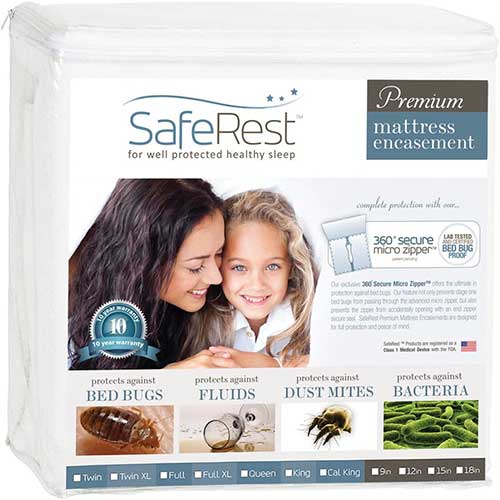
A mattress encasement works by sealing bed bugs that are already in your mattress to keep them from escaping, reproducing, or biting. Eggs, nymphs, and bed bugs in your mattress will be trapped and eventually die as long as you use the right product.
The SafeRest bed bug mattress encasement is a good example of what you should be using. Its zipper has very fine teeth and there’s a flap at the ends of the zipper. Bed bugs are small and flat enough to crawl through regular zippers with no trouble!
After installing your new mattress encasement, leave it on for at least 12 months. You may be surprised to learn adult bed bugs can live a year or even longer in ideal conditions without food. Bed bugs survive best without food in chilly conditions. The warmer the temperature, the faster they will die. With a constant temperature of 80 degrees Fahrenheit, adult bed bugs will be dead within 40-90 days. By leaving the mattress encasement on for a year, you can be sure they’re all dead when you do take it off.
Spread Silica Gel
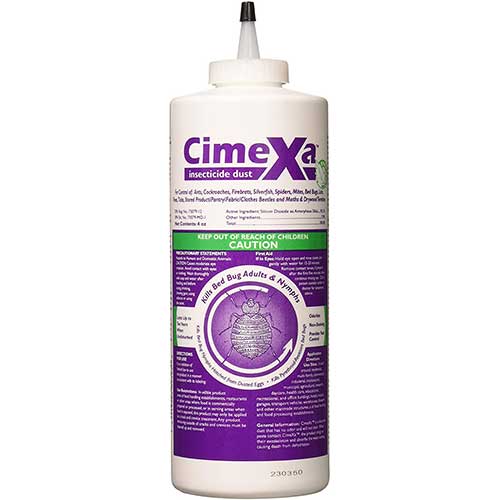
Forget diatomaceous earth (DE), the supposed ideal bed bug powder. While it does kill bed bugs, it isn’t very effective because bed bugs are very resistant to desiccation or dehydration.
Silica gel is made from sand and works like diatomaceous earth but with greater speed and efficacy. Silica gel first causes tiny cuts in the cuticle or exoskeleton of the bed bug. It then literally pulls moisture out of the insect’s body. That’s why you find silica gel packets in electronics and clothes: it’s a powerful drying agent that works much better against bed bugs than diatomaceous earth. It’s also non-toxic and safe to use around your bed and clothing although you want to be careful that you don’t inhale the dust.
When using silica gel, make sure you choose a product with 100% amorphous silica gel like CimeXa insecticide dust or Harris Bed Bug Killer Silica Powder.
According to trials conducted at the University of Kentucky, silica gel kills all bed bugs within 24-48 hours of direct exposure to a barely visible amount. That makes silica gel faster-acting and more effective than even EcoRaider. It even performs very well in real-world settings, killing 98.1% of bed bugs in infested apartments when used alone.
To use silica gel, apply it dry as a powder with a combination of powder dusters (included with the product) and brushes like old cosmetic brushes and paintbrushes. Apply the powder to cracks, voids, and hard-to-reach areas including around baseboards, light switch covers, and the headboard. Use the silica gel to create a barrier across flooring transitions, doorways leading to your bedroom, and across the doorway of your closet.
Related Article: Does Diatomaceous Earth Kill Bed Bugs
Clean Clothes and Bedding
Here’s some bad news. Bed bugs, eggs, and nymphs aren’t just hiding in and around your bed; they’re probably hanging out in your clothes and other linens, too. Bed bugs probably think your closet and dresser are great places to hide and reproduce but the good news is it’s very easy to kill bed bugs on clothes and bedding.
A quick run through the washer and dryer on the hottest possible heat settings will be enough to kill adult bed bugs, nymphs, and heat-resistant eggs.
Carefully remove everything from your bedroom that you can wash and dry including bedding, spare blankets, clothing, and curtains. To avoid spreading the problem to other areas of your home, seal these items in disposable trash bags to transport to the laundry room. Once there, unseal the items one bag at a time and dump directly into the full washing machine. Don’t forget to throw away the now contaminated bags.
Once your belongings are dry, place them in new plastic trash bags and seal them up. Keep all items sealed until the bedroom is fully treated.
Add Interceptors to the Feet of Your Bed
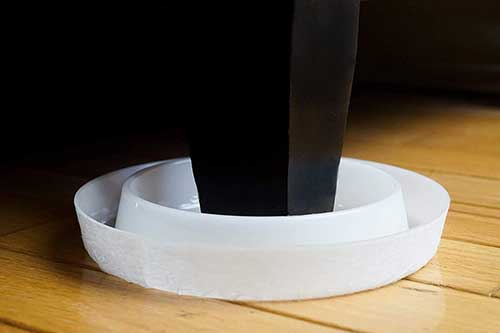
Interceptors are an affordable way to check for the presence of bed bugs in your bed and help catch them as they try to get in bed with you. Interceptors are placed under the legs of your bed frame. When bed bugs try to crawl in the bed, they have to crawl over the interceptors. The design traps them with high, slippery walls and a moat.
ClimbUp interceptors definitely can’t stop bed bug infestation but they create yet another defense to keep the bed bugs at bay. Unlike other brands, they have a two-wall system so you can see if the trapped bed bugs were crawling into your bed — or out of it.
Vacuum Thoroughly
Don’t overlook the importance of simple vacuuming, especially if you have carpet. Imagine all of the hidden bugs, immature nymphs, and eggs that can be lurking in your comfy bedroom carpeting. A vacuum definitely won’t suck up all of the bugs hidden in your carpet but it can get a good amount to reduce the size of the infestation.
Go over your mattress carefully with a vacuum attachment, paying attention to the seams, stitching, and tag area. A stiff brush is helpful for loosening any eggs or nymphs on the surface. Go over your headboard and box springs, too, then cover the floor around and under the bed, the baseboards, the nightstand, and other nooks and crannies in the room.
Be sure to seal and throw away the vacuum bag as soon as you’re done!
Frequently Asked Questions
Can Bed Bugs be Killed with Heat?
Yes, a bed bug’s greatest weakness is heat. You can’t just crank up your thermostat, though: it takes a consistent temperature of 125 degrees F for a minimum of 20 minutes to kill adults, nymphs, and eggs.
Applying heat treatments to kill bed bugs can be harder than it sounds. Even if the air temperature is high enough, it may not get hot enough inside a mattress or other hiding place. Still, heat can effectively drive bed bugs out of their hiding spots.
Heat is becoming the preferred method of professionally treating bed bugs thanks to their growing resistance to pesticides. You can skip the expensive heat chambers, though. You can use heat to kill bed bugs with your clothes dryer, a steam cleaner, and even black plastic bags and a hot, sunny day.
Running items through the dryer for 30 minutes on the highest setting will even kill heat-resistant eggs.
You can also use a steam cleaner to apply sufficient heat directly to items like your mattress, baseboards, and furniture. Make sure your steamer gets hot enough and apply the heat very steadily. As long as you go slowly, you can even see adult bed bugs crawl out of hiding.
For items that don’t fit in the dryer, seal them in a black, plastic garbage bag and leave in direct sunlight on a hot day. The contents of the bag can reach 40 to 70 degrees above the outdoor air temperature after several hours. To be effective, it needs to be at least 80 to 90 degrees outside. To play it safe, leave the items in the sun for the entire day.
Do Essential Oils Work for Bed Bugs?
On the subject of bed bug sprays that really work, let’s spend a moment discussing essential oils. Essential oils are frequently on lists of DIY bed bug treatments but most are useless at doing anything more than making your home smell good. Tea tree oil, for example, is often touted as a bed bug killer but it only has limited results and only with direct contact. Most essential oils offer the same results or worse — doing nothing to bed bugs on contact except giving them an expensive perfume.
A study published in the Journal of Economic Entomology compared the results of 18 essential oils, three silicone oils, and paraffin oil against bed bugs. The most effective essential oil was blood orange oil but it still wasn’t as effective as the paraffin oil and silicone oils. One silicone oil in particular which mixes well with water killed 92% of bed bugs after one day after direct exposure.
There are definitely more effective products you can buy at a low cost, including EcoRaider and Bed Bug Patrol. Still, you could potentially use the results of this study to create your own DIY bed bug spray.
I wouldn’t recommend it, though. To begin with, paraffin oil is flammable and you definitely don’t want to spray it around your house. A good water-soluble silicone oil can also be hard to find and may be fairly expensive. Skip the essential oils and use something like EcoRaider for well-tested results and a lower cost with the same environmentally-friendly properties.
Related Article: How to Get Rid of No-See-Ums
Can Rubbing Alcohol be a Bed Bug Spray?
No, We’ll end with an important caution about rubbing alcohol and why you should avoid it at all costs. Unfortunately, people continue to use rubbing alcohol as a DIY bed bug spray around their home — sometimes with deadly results.
Despite the dangers, you may still see rubbing alcohol recommended to repel or kill bed bugs.
It’s true that a 91% isopropyl alcohol solution may help kill some bed bugs by acting as a drying agent and even partially dissolving an insect’s cells. As with most other drying agents like diatomaceous earth, the results simply aren’t that great.
A 2013 Rutgers University study found that rubbing alcohol killed only up to 50% of bed bugs that were directly sprayed with the solution after four days.
There are definitely better options out there.
In addition to its low efficacy, this treatment requires dousing your mattress, furniture, and belongings with a highly flammable liquid.
Several house fires across the United States have been started by rubbing alcohol in an attempt to kill bed bugs. In Cincinnati, a teenager trying to kill a bed bug with alcohol in 2017 started a massive apartment fire that damaged six units. A man in Mount Carmel, Ohio in 2011 accidentally set his apartment on fire after trying to kill bed bugs with alcohol while smoking. These aren’t isolated incidents, either.
Instead of risking your life and home to exterminate bed bugs, use safe and proven methods like EcoRaider, silica gel, mattress encasements, and the other techniques explained above.
Related Article: How to Get Rid of Spiders Fast
My name is Blane and I’m a life-long resident of Southeastern Louisiana. I’ve been working as Pest Control Technician and Inspector for about 1.5 years now.
I’ve worked in many other industries as well, including consulting, managing, as well as at the ground level in fields including Food Service, Corporate Automotive sales, and finance. Whether it be providing counsel, content, or hands-on support; my goal remains to add value to the lives of the people I serve.
If you have any questions regarding pest control, leave them below. I would be happy to help you out in any way I can.

Thank you for all the great information! Glad to have confirmation for the non-toxic EcoRaider spray, silica gel, and other treatment traps!